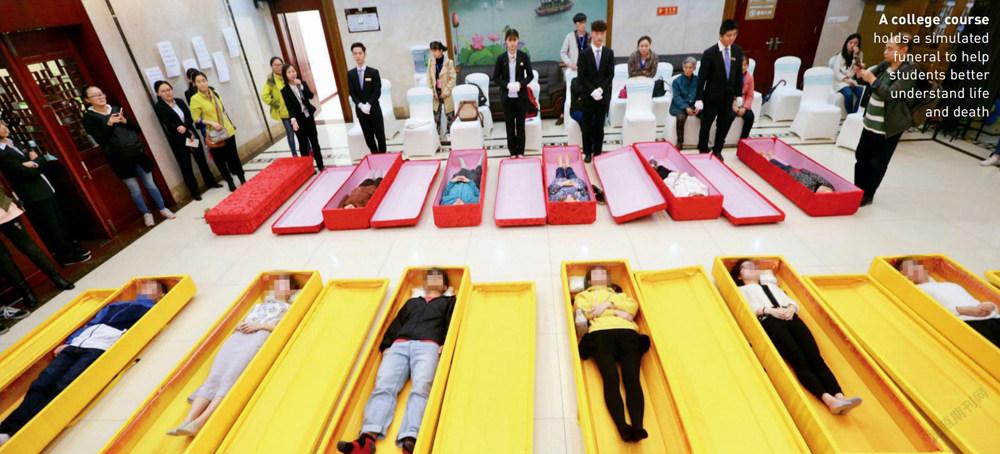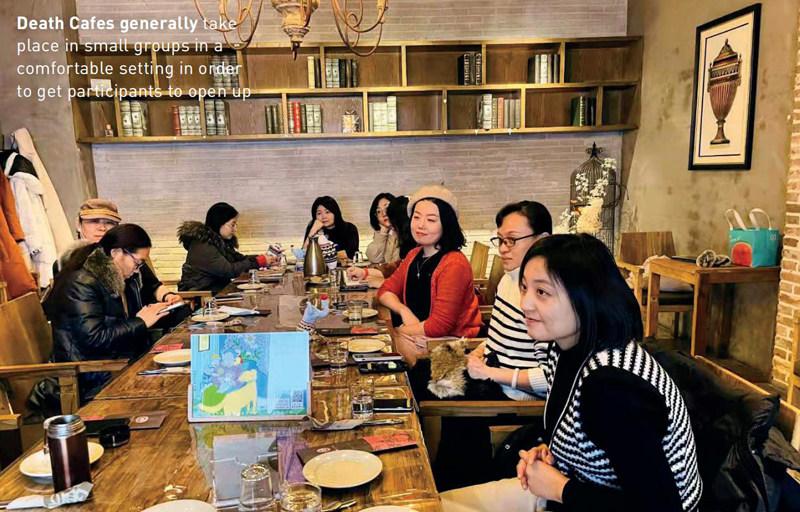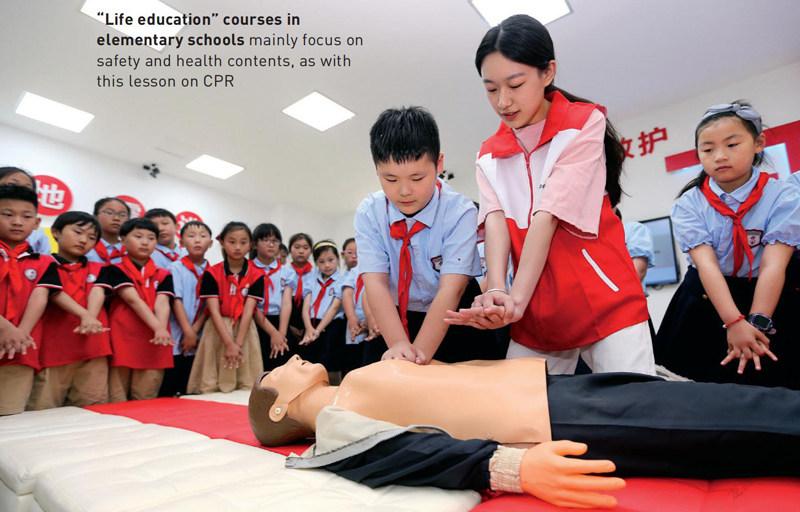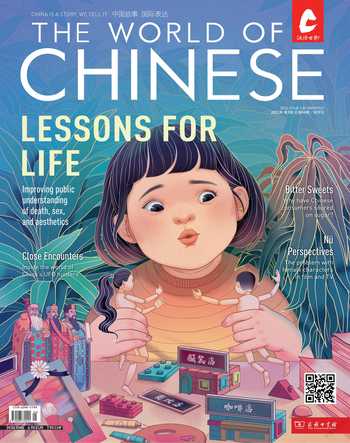Death Discussions
2022-06-15谭云飞
谭云飞



Last autumn, 19-year-old Liao Zhiruo spent a whole afternoon writing her last will and testament. Taking the form of a letter addressed to her parents in the event of her early death, the will asked them to keep living a good life without her.
The letter is part of an exercise Liao was assigned to do by an elective course called “Death Culture and Life and Death Education,” which the college sophomore took last term at Shandong University in Jinan, Shandong province. Other assignments of the course included imagining a world with no doctors, and visiting a funeral parlor. “People normally find it taboo to mention death, so everything about the course attracted me, from its name to the [funeral visit] activity,” says Liao, telling TWOC that after this experience, she started trying to start conversations about death with her parents. “They’re not very open-minded, but I think we can take it slow.”
Liao is not alone in wanting to learn more about death. “The course has 120 seats, but since the very first year it was offered, it has always been full, and students have to join a ‘lottery’ at the start of the semester to get admitted,” Wang Yunling, founder and lecturer of the course, tells TWOC. The course is one of a few of its kind in China, and covers topics like life, death, dying experience, suicide, death with dignity, palliative care, euthanasia, funeral culture, and grief counseling.
But it wasn’t always smooth-sailing. When Wang proposed the course in 2006, university administrators rejected the proposal over concerns that the topics might promote suicide or increase students’ anxiety, though the medical school permitted it as an elective course after it learnt of similar courses in the West. More than 15 years later, similar concerns have barred courses on death from curriculums in the Chinese mainland, except in around 20 colleges and a handful of primary and middle schools, Wang estimates.
“Chinese people have an elementary school student’s understanding of death, because there has never been true death education in China,” journalist Bai Yansong of the state broadcaster China Central Television claimed at a public forum in Beijing in May 2016. Bai attributed this mainly to folk beliefs in China’s dominant Han culture that talking about death is unlucky. Confucian teachings generally deal with a person’s relationships and obligations in the living world, in contrast to Judeo-Christian and other religious traditions that hold death—and afterlife—to be a major part of their faith.
Wang partially agrees with Bai, and adds that the “medicalization of death”—viewing death purely from a medical perspective—in modern China has exacerbated people’s fear and misunderstanding of it. “Both medical professionals and the public refuse to accept death as a natural part of human life, and they use medical terms to identify, describe, and understand it, as well as avert it,” he says. Taken to an extreme, “this means ordinary people...think that as long as there is technology and as long as I have the money, I can get the physician to do whatever it takes to save me.”
Originated in the US in the mid-20th century as the study of thanatology, the idea of death education emerged on the Chinese mainland with the discussion on whether euthanasia should be legalized in China in the 1980s. A “Philosophy of Death” course started by Professor Duan Dezhi of Wuhan University in 1991 is believed to be the first of its kind. However, courses on death have often been referred to euphemistically as “life education (生命教育)” and “life and death education (生死教育).”
Death education, to Wang, mainly aims to “help people understand that death is an inevitable part of the natural course of human being, to face their death and that of others correctly,” and “awaken the students’ awareness of death, so that they cherish their health and life, make good plans for life, live their values, and learn the meaning of life.” He believes that ignorance about death, which in turn leads to a disregard for life, is partially responsible for tragedies involving teenagers and college students killing themselves or others, or young people lacking meaning or direction in their lives.
Voicing similar concerns, Cao Hui, a member of the Chinese People’s Political Consultative Conference (CPPCC), one of China’s top legislatures, proposed to make life and death education a compulsory part of the primary and middle school curriculum in May 2020. He stated that the taboo of talking about death was partially responsible for “suicide attempts” and reckless behaviors, and suggested courses run by specialized professional teachers from primary school, or even kindergarten, up to college level.
Nevertheless, courses and initiatives surrounding death education have encountered widespread resistance due to their name and content. While his university did not explain why they initially rejected his course proposal, Wang believes that educators worry that death-themed courses may encourage students to commit suicide, which he says is unfounded.
Students are far more open to such courses. “Children have too many ways to get information on the internet, and are more open-minded,” Wang observes. Besides students at his own university, over 130,000 students nationwide have studied the subject through online learning platform Treenity after Wang launched his course there in 2015.
Other instructors have not been as successful. Professor Yuan Changgeng of Southern University of Science and Technology in Shenzhen, who taught the course “Understanding Death,” once got a call from an administrator at midnight accusing him of “destroying” their university’s image after students shared photos on social media of a mock funeral they staged in the class. Yuan told the blog Trueman Story that after this, he stopped offering practical exercises in his course.
Wang is also cautious about the “hands-on” portions of the course, noting that the majority of life and death education courses in China are still theory-based. All “practical” activities in Wang’s course, including the funeral parlor visit, trips to palliative wards, and simulated funerals, are optional, so that participation will not affect students’ final marks. “There are risks: If students develop mental issues [from these activities], the teacher will be held responsible, and the school may also be criticized,” he explains. He estimates that around half of his 120 students each semester don’t join the funeral parlor visit.
It has been even more difficult to promote death education in elementary and middle schools. CPPCC member Cao complained these courses were “practically inexistent,” while Wang tells TWOC that so-called “life education” at this level mainly concentrates on safety and health, instead of death. He believes the exam-oriented education system and the lack of trained teachers are to blame.
Liu Lianhua, a Chinese teacher from an elementary school in the city of Hengyang in central China’s Hunan province, tells TWOC that her school has offered a course called “Common Life and Health Knowledge” for years. However, the course was taught by the math teacher, who mostly just asked students to read the textbook, and Liu herself would often cancel this session to offer her students extra Chinese classes.
Meanwhile, there have been efforts to break the taboo outside of schools. Shanghai Hand in Hand Life Care and Development Center, China’s first NGO to focus on palliative care, started their “Death Cafe” in 2014. A model originally from the UK and based on the ideas of Swiss sociologist and anthropologist Bernard Crettaz, Death Cafes are gatherings where people meet to discuss death and how to make the most of their lives over desserts and drinks. Since starting the project in China, Hand in Hand has trained nearly 700 group leaders who have organized over 700 Death Cafes involving an estimated 10,000 people from 55 cities, as of the end of 2021.
Typically, a session comprises a dozen attendees and lasts for two to three hours, in which members take turns to share almost anything death-related, including personal experiences, discussions of funeral customs, and depictions of death in popular culture. Wu Ning, a Beijing organizer, observes there are young people who want to understand how they should live, as well as middle-aged people and retirees who want to learn about health conditions and care for aging parents.
Wu joined Hand in Hand’s two-day training session in September of 2020, one year after her mother died of cancer. In the last three months of her life, Wu’s mother lived at home, forgoing excessive and potentially painful medical treatment. This gave Wu a favorable view of palliative care, instead of invasive treatments that cause suffering for critically ill patients.
According to Wu, Death Cafes give people an opportunity to talk freely about what’s on their mind, “since many people feel awkward discussing [problems] with their families.” In addition, “there are always more experienced and wiser participants who can give you another perspective to your problem,” Wu says, explaining how one member helped her get over regrets she had about her mother’s last days. Ma Bijie, a 36-year-old who has joined several Beijing Death Cafes, says she appreciates the lack of “taboo and prejudice” against the topic of death in cafe meetings and WeChat groups, comparing this to “group therapy.”
However, not everyone is on board. Huang Weiping, co-founder of Hand in Hand, says he gets feedback from event attendees who find the word “death” frightening and suggest that he rename the Death Cafe to something “warmer.” He also says the majority of Death Cafes trainings and public sessions are held in Beijing, Shanghai, Guangzhou, and Chengdu, and trainees are mostly professionals from sectors like education, health care, and social work. “We tried at a couple of less-developed cities like Changchun in Jilin province, but could hardly find enough trainees,” he says.
Still, there has been progress in many respects. Wang tells TWOC that his university made his course an elective open to all students on campus last year, while over 40,000 netizens watched the livestream of Peking University’s Qingming Forum, a public event on life-and-death education, this March. In September, the 7th Seminar on Death in Contemporary China, an academic forum launched by several universities, will discuss efforts to make death-themed courses compulsory for medical students in China, as it is in many Western countries. Wang also observes that the number of volunteers in palliative care services in his province and other parts of the country has been growing.
In the last three years, an increasing number of minors aged 9 to 16 and their parents have attended Death Cafes, according to Huang, which he believes a good sign. “Once parents are open-minded enough, there will be no need for them to attend events like this, and they can talk at home.”
Ma, a mother of a 4-year-old, agrees it’s positive for parents to learn about death. “If we don’t regard death as a taboo but a part of daily life, it will be easy for our children to accept it…it will make a smooth and natural transition from our generation to the next.”
